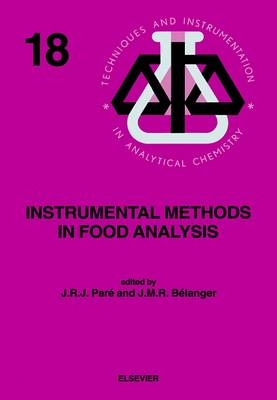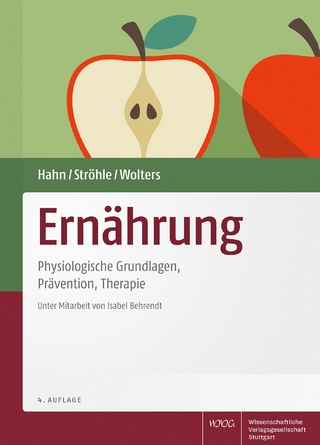
Instrumental Methods in Food Analysis
Elsevier Science Ltd (Verlag)
978-0-444-81868-3 (ISBN)
- Titel ist leider vergriffen;
keine Neuauflage - Artikel merken
Instrumental Methods in Food Analysis is aimed at graduate students in the science, technology and engineering of food and nutrition who have completed an advanced course in food analysis. The book is designed to fit in with one or more such courses, as it covers the whole range of methods applied to food analysis, including chromatographic techniques (HPLC and GC), spectroscopic techniques (AA and ICP), electroanalytical and electrophoresis techniques. No analysis can be made without appropriate sample preparation and in view of the present economic climate, the search for new ways to prepare samples is becoming increasingly important. Guided by the need for environmentally-friendly technologies, the editors chose two, relatively new techniques, the microwave-assisted processes (MAPTM (Chapter 10) and supercritical fluid extraction (Chapter 11). Features of this book: - is one the few academic books on food analysis specifically designed for a one semester or one year course -it contains updated information - the coverage gives a good balance between theory, and applications of techniques to various food commodities. The chapters are divided into two distinct sections: the first is a description of the basic theory regarding the technique and the second is dedicated to a description of examples to which the reader can relate in his/her daily work.
1. Chromatography: Principles and applications (J.M.R. Bélanger et al.). Introduction - historical background. Chromatography: A separation technique. Theory. Physical forces and interactions. Modes of separation. Stationary phases versus mobile phases. Planar chromatography. Column chromatography. Detectors. Preparative liquid chromatography (Prep LC). Special topics. Future trends. Summary. Applications to food analysis. General bibliography. References cited. 2. High performance liquid chromatography (HPLC): Principles and applications (J.M.R. Bélanger et al.). Introduction. Range of applications. Theory of liquid chromatography. The mobile phase - The solvent. Instrumentation. Some advantages of HPLC over other techniques. Applications of HPLC to food analysis. Future trends. References. 3. Gas chromatography (GC): Principles and applications (Z. Wang, J.R.J. Paré). Introduction. Principles. Definitions. Theory of gas chromatography. The application of the rate theory. Instrumentation. Instrumentation summary. Applications of GC to food analysis. References. 4. Fourier transform infrared spectroscopy: Principles and applications (A.A. Ismail et al.). Introduction. Principles of infrared spectroscopy. Instrumentation. Data handling techniques. Quantitative analysis. Sampling methods. Applications. Conclusions. References. 5. Atomic absorption, emission and fluorescence spectrometry: principles and applications (W.D. Marshall). A brief historical perspective of atomic spectroscopy. Introduction to atomic absorption spectroscopy (AAS). How are atomic absorbances measured? Components of an AA spectrometer. AAS, a relative technique. Interferences. Calibration techniques. Minimising uncertainties. Non-flame atomisation techniques. Atomic emission spectrometry (AES). Flame, furnace or plasma - which to choose? Atomic fluorescence spectrometry (AFS). Trace metal determinations in biological samples. References. 6. Nuclear magnetic resonance spectroscopy (NMR): Principles and applications (C. Deleanu, J.R.J. Paré). Introduction. Notes on literature. The electromagnetic spectrum. The NMR phenomenon. Types of information provided by the NMR spectra. More relaxaton. Instrumental and experimental considerations. Future trends. Applications of NMR to food analysis. References. 7. Mass spectrometry: Principles and applications (J.R.J. Paré, V. Yaylayan). Introduction. The process. Other ionisation techniques. Instrumentation. Linked-scanning techniques. Applications of mass spectrometry in food science - applications of GC/MS. References. 8. Electroanalytical techniques: Principles and applications (J.G. Dick). General Introduction. Direct potentiometry - ion-selective electrodes. Indirect potentiometry - potentiometric titrations. Voltammetric and polarographic methods. Polarisation titrations. Coulometry and conductometry. Electrochemical detectors. References. 9. Capillary electrophoresis: Principles and applications (S. Swedberg). Introduction. Overview of analyses by CE: a flexible analytical tool. Flexibility in mode of separation: the five major modes of CE. Applications of CE in analysis of substances in food. Conclusion. References. 10. Microwave-assisted process (MAPTM): Principles and applications (J.R.J. Paré J.M.R. Bélanger). Introduction. Safety considerations. The process. Examples of applications of MAP in food science. Conclusion. References. 11. Supercritical fluid extraction: Principles and applications (D.R. Gere et al.). Introduction. Principles of supercritical fluids. An overview of analytical-scale SFE instrumentation. Examples of SFE methods in food and food products. Summary and conclusions. Bibliography.
| Erscheint lt. Verlag | 14.3.1997 |
|---|---|
| Reihe/Serie | Techniques & Instrumentation in Analytical Chemistry |
| Verlagsort | Oxford |
| Sprache | englisch |
| Themenwelt | Medizin / Pharmazie ► Gesundheitsfachberufe ► Diätassistenz / Ernährungsberatung |
| Naturwissenschaften ► Chemie ► Analytische Chemie | |
| Technik ► Lebensmitteltechnologie | |
| ISBN-10 | 0-444-81868-5 / 0444818685 |
| ISBN-13 | 978-0-444-81868-3 / 9780444818683 |
| Zustand | Neuware |
| Haben Sie eine Frage zum Produkt? |
aus dem Bereich


